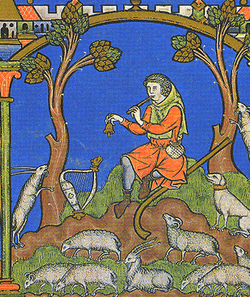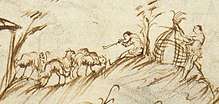Medieval English wool trade
The medieval English wool trade was one of the most important factors in the medieval English economy. 'No form of manufacturing had a greater impact upon the economy and society of medieval Britain than did those industries producing cloths from various kinds of wool'.[1] The trade's liveliest period, 1250–1350, was 'an era when trade in wool had been the backbone and driving force in the English medieval economy'.[2]

The wool trade was a major driver of enclosure (the privatisation of common land) in English agriculture, which in turn had major social consequences, as part of the British Agricultural Revolution.
Among the lasting monuments to the success of the trade are the 'wool churches' of East Anglia and the Cotswolds; the London Worshipful Company of Clothworkers; and the fact that since the fourteenth century, the presiding officer of the House of Lords has sat on the Woolsack, a chair stuffed with wool.
Early Middle Ages

During the early Anglo-Saxon period (c. 450–650), archaeological evidence for subsistence-level wool production using warp-weighted looms is extensive. Tools and technologies of spinning and weaving were similar to those of the Roman period; it is likely that fine, white wool continued to be produced from sheep introduced from the Mediterranean region alongside coarser local wools. Dyes included woad for blue and less frequently madder and lichens for reds and purples. Some high-status woollen cloth is found, including gold brocade.[3] New textile types appeared around the tenth century, prominently including diamond twills whose use continued into the thirteenth century.[4] There is little evidence for long-distance trade, but there seems to have been some, presumably of especially rare wools or cloths:[5] the silence of the sources is punctuated by a famous mention of the slipping standards of English cloaks exported to Frankia in a letter from Charlemagne to Offa of Mercia.
Later Middle Ages
.png)

Subsistence-level production of wool continued,[6] but was overshadowed by the rise of wool as a commodity, which in turn encouraged demand for other raw materials such as dyestuffs; the rise of manufacturing; the financial sector; urbanisation; and (since wool and related raw materials had a high value-to-weight ratio and were easily transported) regional, international, and even intercontinental trade.[7]
English wools, particularly from the Welsh Marches, the South West and Lincolnshire, were the most prized in medieval Europe.[8] It was exported to the emergent urban centres of cloth production of the Low Countries, France, and Italy, where production was promoted by the adoption of the pedal-driven horizontal loom and spinning wheel, along with mechanised fulling and napping.[9]
In 1280 about 25,000 sacks of wool were exported from England; trade in raw wool peaked around 40,000–45,000 sacks per year, falling to 33,000 in 1355 and 9,706 in 1476 as exports changed to finished cloth. As exports of raw wool fell, exports of cloths rose, from 10,000 cloths per year in 1349–50 to 60,000 in 1446–47, and c. 140,000 in 1539–40.[10] 'By the end of the thirteenth century, the heavily industrialised areas of Europe could not have existed without the export of English wool.'[11]
England's wool-trade was volatile, however, affected by diverse factors such as war, taxation policy, export/import duties or even bans, disease and famine, and the degree of competition among European merchants for English wool. For example, since Continental industry relied on English wool, and export embargoes could 'bring whole areas to the brink of starvation and economic ruin', the wool trade was a powerful political tool. Likewise, taxes on the wool trade financed Edward I's wars and enabled England to conduct the Hundred Years' War with better resources than France. These instabilities led to a boom-bust cycle in prices and exports.[12]
In the twelfth and thirteenth centuries, the English wool trade was primarily with Flanders (where wool was made into cloth, primarily for sale via the Champagne fairs into the Mediterranean basin), and was dominated by Flemish merchants. But in 1264, the strife in England of the Second Barons' War brought Anglo-Flemish trade almost to a halt and by 1275, when Edward I of England negotiated an agreement with the domestic merchant community (and secured a permanent duty on wool), Italian merchants had begun to gain dominance in the trade. Extending their activities to finance, the Riccardi, a group of bankers from Lucca in Italy, became particularly prominent in English taxation and finance.[13] Among the most famous merchants participating in the English wool trade were Jean Boinebroke of Douai (d. 1286) on the Continental side,[14] and William de la Pole (d. 1366) on the English.
Guild organisations seem to have emerged in the textile industry earlier in England than elsewhere in Europe, being attested already in the 1130s in London, Winchester, Lincoln, Oxford, Nottingham, and Huntingdon.
Early Modern period
By the sixteenth century, the quality of English wools was in decline, perhaps partly due to a switch in focus to meat production for domestic urban markets, and European supremacy in the production of fine-wool passed to the Iberian peninsula and its merino sheep.[15]
Key statistics
The table charts English woolsack and broadcloth exports, in five-year means, 1281–1545.[16]
| Years Michaelmas | Woolsack exports (5-yr means) | Broadcloth exports | Total as equivalent broadcloth |
|---|---|---|---|
| 1281–5 | 26,879.20 | 116,554.44 | |
| 1286–90 | 26,040.80 | 112,843.38 | |
| 1291–5 | 27,919.20 | 120,983.11 | |
| 1296–1300 | 23,041.20 | 99,845.12 | |
| 1301–5 | 32,344.00 | 140,157.23 | |
| 1306–10 | 39,016.20 | 169,070.07 | |
| 1311–15 | 35,328.60 | 153,090.48 | |
| 1316–20 | 26,084.60 | 113,033.18 | |
| 1321–25 | 25,315.40 | 109,699.98 | |
| 1326–30 | 24,997.60 | 108,322.85 | |
| 1331–35 | 33,645.60 | 145,797.49 | |
| 1336–40 | 20,524.80 | 88,940.73 | |
| 1341–45 | 18.075.58 | 78,327.43 | |
| 1346–50 | 27,183.13 | 2,556 | 120,349.12 |
| 1351–55 | 30,750.40 | 1,921 | 135,172.83 |
| 1356–60 | 32,666.40 | 9,061 | 150,615.29 |
| 1361–65 | 30,129.20 | 11,717 | 142,276.97 |
| 1366–70 | 26,451.80 | 14,527 | 129,151.58 |
| 1371–75 | 25,867.80 | 12,211 | 124,305.11 |
| 1376–80 | 20,470.20 | 13,643 | 102,346.73 |
| 1381–85 | 17,517.40 | 22,242 | 98,150.67 |
| 1386–90 | 19,312.00 | 25,610 | 109,295.27 |
| 1391–95 | 18,513.80 | 39,525 | 119,751.60 |
| 1396–1400 | 16,889.60 | 38,775 | 111,963.31 |
| 1401–5 | 12,904.20 | 34,570 | 90,487.76 |
| 1406–10 | 14,968.20 | 31,746 | 96,609.35 |
| 1411–15 | 13,593.20 | 27,183 | 86,087.22 |
| 1416–20 | 14,365.00 | 27,977 | 90,225.49 |
| 1421–25 | 14,425.20 | 40,275 | 102,003.75 |
| 1426–30 | 13,358.60 | 40,406 | 98,292.82 |
| 1431–35 | 9,384.60 | 40,027 | 80,693.97 |
| 1436–40 | 5,378.80 | 47,072 | 70,380.12 |
| 1441–45 | 8,029.40 | 56,456 | 91,249.84 |
| 1446–50 | 9,765.20 | 45,847 | 88,162.63 |
| 1451–55 | 8,790.80 | 36,700 | 74,793.44 |
| 1456–60 | 6,386.40 | 36,489 | 64,163.38 |
| 1461–65 | 6,386.00 | 29,002 | 56,674.25 |
| 1466–70 | 9,293.60 | 37,447 | 77,719.64 |
| 1471–75 | 8,453.40 | 36,537 | 73,168.57 |
| 1476–80 | 8,736.00 | 50,441 | 88,296.77 |
| 1481–85 | 7,621.40 | 54,198 | 87,223.84 |
| 1486–90 | 9,751.00 | 50,005 | 92,259.50 |
| 1491–95 | 6,755.20 | 56,945 | 86,217.11 |
| 1496–1500 | 8,937.20 | 62,853 | 101,311.24 |
| 1501–5 | 7,806.80 | 77,271 | 111,100.24 |
| 1506–10 | 7,326.20 | 84,803 | 116,549.44 |
| 1511–15 | 7,087.20 | 86,592 | 117,303.18 |
| 1516–20 | 8,194.40 | 90,099 | 125,607.84 |
| 1521–25 | 5,131.60 | 82,269 | 104,505.72 |
| 1526–30 | 4,834.80 | 93,534 | 114,485.18 |
| 1531–35 | 3,005.20 | 94,087 | 107,109.32 |
| 1536–40 | 3,951.40 | 109,278 | 126,400.72 |
| 1541–45 | 4,576.00 | 118,056 | 137,884.92 |
Key studies
Key studies of the topic include:
- Eileen Power, The Wool Trade in English Medieval History: Being the Ford Lectures [1939] (London: Oxford University Press, [1941])
- T. H. Lloyd, The English Wool Trade in the Middle Ages (Cambridge: Cambridge University Press, 1977)
References
- John H. Munro, 'Medieval Woollens: Textiles, Textile Technology and Industrial Organisation, c. 800–1500', in The Cambridge History of Western Textiles, Volume 1, ed. by D. T. Jenkins (Cambridge: Cambridge University Press, 2003), pp. 181–227 (at 181).
- Adrian R. Bell, Chris Brooks, Paul R. Dryburgh, The English Wool Market, c.1230–1327 (Cambridge: Cambridge University Press, 2007), p. 1.
- Penelope Walton Rogers, 'The Anglo-Saxons and Vikings in Britain, AD 450–1050', in The Cambridge History of Western Textiles, Volume 1, ed. by D. T. Jenkins (Cambridge: Cambridge University Press, 2003), pp. 124–32 (at 124–27).
- Penelope Walton Rogers, 'The Anglo-Saxons and Vikings in Britain, AD 450–1050', in The Cambridge History of Western Textiles, Volume 1, ed. by D. T. Jenkins (Cambridge: Cambridge University Press, 2003), pp. 124–32 (at 130).
- John H. Munro, 'Medieval Woollens: The Western European Woollen Industries and their Struggles for International Markets, c. 1000–1500', in The Cambridge History of Western Textiles, Volume 1, ed. by D. T. Jenkins (Cambridge: Cambridge University Press, 2003), pp. 228–324 (228).
- D. T. Jenkins, 'Introduction', in The Cambridge History of Western Textiles, Volume 1, ed. by D. T. Jenkins (Cambridge: Cambridge University Press, 2003), pp. 179–80 (at 180).
- John H. Munro, 'Medieval Woollens: Textiles, Textile Technology and Industrial Organisation, c. 800–1500', in The Cambridge History of Western Textiles, Volume 1, ed. by D. T. Jenkins (Cambridge: Cambridge University Press, 2003), pp. 181–227 (at 181).
- John H. Munro, 'Medieval Woollens: Textiles, Textile Technology and Industrial Organisation, c. 800–1500', in The Cambridge History of Western Textiles, Volume 1, ed. by D. T. Jenkins (Cambridge: Cambridge University Press, 2003), pp. 181–227 (at 186–89).
- John H. Munro, 'Medieval Woollens: Textiles, Textile Technology and Industrial Organisation, c. 800–1500', in The Cambridge History of Western Textiles, Volume 1, ed. by D. T. Jenkins (Cambridge: Cambridge University Press, 2003), pp. 181–227 (194–211).
- Adrian R. Bell, Chris Brooks, Paul R. Dryburgh, The English Wool Market, c.1230–1327 (Cambridge: Cambridge University Press, 2007), pp. 3, 9.
- Adrian R. Bell, Chris Brooks, Paul R. Dryburgh, The English Wool Market, c.1230–1327 (Cambridge: Cambridge University Press, 2007), p. 1.
- Adrian R. Bell, Chris Brooks, Paul R. Dryburgh, The English Wool Market, c.1230–1327 (Cambridge: Cambridge University Press, 2007), p. 1.
- Emilia Jamroziak, 'Rievaulx Abbey as a Wool Producer in the Late Thirteenth Century: Cistercians, Sheep, and Debts', Northern History, 40 (2003), 197–218 (pp. 200–1).
- John H. Munro, 'Medieval Woollens: Textiles, Textile Technology and Industrial Organisation, c. 800–1500', in The Cambridge History of Western Textiles, Volume 1, ed. by D. T. Jenkins (Cambridge: Cambridge University Press, 2003), pp. 181–227 (219).
- John H. Munro, 'Medieval Woollens: Textiles, Textile Technology and Industrial Organisation, c. 800–1500', in The Cambridge History of Western Textiles, Volume 1, ed. by D. T. Jenkins (Cambridge: Cambridge University Press, 2003), pp. 181–227 (at 189).
- John H. Munro, 'Medieval Woollens: The Western European Woollen Industries and their Struggles for International Markets, c. 1000–1500', in The Cambridge History of Western Textiles, Volume 1, ed. by D. T. Jenkins (Cambridge: Cambridge University Press, 2003), pp. 228–324 (pp. 304–5).